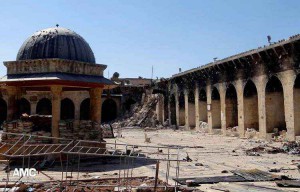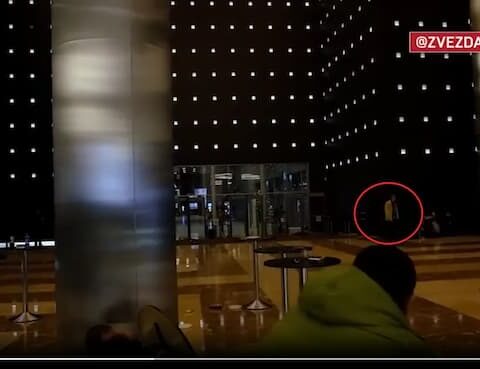As has been feared for weeks now, ISIS/ISIL members are reported to have begun to destroy historic sites in the Syrian city of Palmyra.
The ISIS/ISIL fighters defeated the Syrian Army and took control of the historic city last month. I was watching this story closely and dreading that news. Because, while any town or city taken by the extremist militants is bad news, the 2,000 year-old city of Palmyra – a UNESCO World Heritage site – is now in very real danger of having its historic sites wrecked by the Philistine jihadists.
The cultural destruction in Syria, however, follows the cultural and archaeological destruction in Iraq, not just by the jihadists but by the US-led invasion of 2003.
Irreplaceable sites in Palmyra include the Valley of the Tombs, the Royal Necropolis of Ancient Thebes, the Temple of Baal from the 1st Century AD, the ancient Agora, the Camp of the Roman Emperor Diocletian, Hadrian’s Gate (pictured below), various other temples, and more. The jihadists’ seizure of the city had come after days of drawn-out fighting. Government workers were also among those killed.
Syria’s authorities, including Maamoun Abdulkarim, the Director-General of antiquities and museums, had requested assistance from the international community to protect the 2,000-year-old city from falling into ISIS/ISIL hands; but no such help was forthcoming and the city is now entirely in the militants’ control. While the foreign-funded militants of the Islamic State are ethnically cleansing the contemporary populations of its victim-nations Iraq and Syria, they are also conducting a simultaneous war on the ancient history of both countries and the right of future generations to have access to the living archaeological links to the past.

Syria, home to no less than six Unesco World Heritage sites, is regarded as one of the richest archaeological places in the world, with relics dating back to the ancient Mesopotamian era (3100 BC), including some of the earliest examples of Sumerian writing. Syria was an absolute treasure trove not only of classical Islamic sites, but of Roman and Greek ruins, ancient Christian monasteries and churches, and more.
Apart from Italy and Egypt, it’s difficult to think of richer historical lands than Syria and Iraq. The Old City of Damascus alone contains the house where Saul (Paul) is thought to have stayed after converting to Christianity and some of the mosques date back to the time of the Prophet Mohammad. Palmyra, regarded as “an oasis in the Syrian desert”, is famed for its Roman-era sites, a living monument to Graeco-Roman architecture along with early Islamic heritage and Persian influences.
Fears are growing both in Syria and abroad that the terror group will destroy the various historic sites, just as they have done elsewhere. ISIS has already demonstrated its complete lack of regard for history, culture and heritage. That was evident from as far back as when they planted explosives around the Tomb of the Biblical Prophet Jonah in Iraq and detonated the site. This fanatical and literalist interpretation of Islamic thought that drives ISIS/ISIL’s vandalism of historic sites is inspired by the 18th-century cleric, Mohammed Ibn Abd al-Wahhab, the founder of ‘Wahhabism’ and the most intolerant interpretation of the religion.
Those who consider this wanton destruction somehow symptomatic of ‘Islamic attitudes’ in general are indulging in a nonsensical view, as these same historic sites in Syria and Iraq have stood, unscathed, through centuries and centuries of entirely Muslim control, just as important Christian sites in Jerusalem have. It is the relatively modern extremist ideology that is enabling such acts to be justified.
If the ISIS fighters do decide to destroy Palmyra’s cultural treasures (the reports in the last few days suggest only two sites so far, both entirely Islamic sites, have been destroyed), it will be the latest in a spate of their methodical destruction of historic heritage. Destruction of Assyrian treasures and cities at Mosul, Nimrud (Biblical Nimrod) and Dur-Sharrukin in Iraq have justifiably caused outrage. Ban Ki Moon, the UN Secretary-General, has in fact condemned the wanton destruction of ancient Assyrian and Akkadian heritage sites as a ‘war crime’. Recently when the militants reportedly bulldozed the 2,000-year-old city of Hatra and the Nimrud archaeological site near Mosul in Nineveh province, it made worldwide news, but in fact this kind of thing had been going on for months before that and drawing less attention.
It helped of course that they published a video showing their people destroying artifacts in a Mosul museum and at the Nergal Gate to ancient Nineveh, taking a sledgehammers to ancient sculptures. The videos of ISIS members using hammers and drills to destroy several large statues went viral a few months ago, including one depicting a winged-bull Assyrian protective deity that dated back to the 9th century BC.

Mosul’s public library director Ghanim al-Ta’an told The Fiscal Times that ISIS members had burned the city public library, which had housed more than 8,000 rare old books and manuscripts. In doing so, they are essentially waging war on culture itself – not just the culture of Syria and Iraq, but of the world. This is world heritage we’re talking about: and it is being taken from us and, more importantly, from future generations of Syrians and Iraqis.
However, when we talk about ‘ISIS’ destroying historic sites in Syria and Iraq, we tend to forget that some degree of targeted devastation of Iraq’s cultural heritage was already going on during the US-led invasion from 2003 onwards.
ISIS has been much worse and much more direct, much more blunt (based on their misguided view that all ancient cultures and history are inferior and that artifacts represent ‘idolatry’); but there were incidents of US army personnel wantonly causing damage to Iraqi sites and monuments and there were complaints made by native archaeological experts and conservationists about the behavior of US troops on several occasions.
I was aware of this at the time because I recall seeing the subject covered on a news item, in which tearful Iraqi museum staff were lamenting what was happening to historic monuments and locations. That had always made me wonder whether there was a deliberate policy to begin a long-term destruction of Iraqi cultural antiquities. There was probably wasn’t; those incidents were probably a case of undisciplined, trigger-happy soldiers acting impulsively in some instances and having no respect for the land they were in. However, it is evident that this brazen disrespect for the victim-nation’s historical heritage and culture wasn’t just at the low-level, loutish army element, but was even evident at the *planning* level.
In the site of ancient Babylon itself, the 2,500 year-old brick pavement to the Ishtar Gate was smashed by tanks and the gate itself damaged.
Meanwhile the subsoil, known to have been archaeologically rich, was bulldozed to fill up sandbags and large areas were covered in compacted gravel for the sake of car parks and heli-pads.
Larger than that was the problem of the American occupation failing to implement a site protection plan for anything other than a handful of key locations. This allowed an inestimable amount of Iraqi artifacts and historic items to be looted and sold on the black market; a practise that has of course been continued by the thugs of ISIS/ISIL, who have been selling ancient Iraqi artifacts to finance their military operations in the region. As with the black market in stolen oil and weapons that ISIS makes so much money from, a black market in antiquities and priceless artifacts is also being used to fund the Salafist/Islamist war machine.
Priceless antiquities suspected of being plundered from archaeological sites in Iraq and Syria have been appearing for sale on online auction sites such as eBay.

But long before this, there was famously of course the mass looting of the Iraqi National Museum during the US-led invasion in 2003. At least 13,864 objects were stolen in that massive heist, making it the biggest museum theft in history.
Once the museum staff were able to communicate with the outside world, however, it became apparent that the looting was not random. It was the work of people who knew what they were looking for and came specially equipped for the job. Dr. Dony George, head of the Baghdad Museum, told Channel 4 News in the UK that among the artifacts that had been stolen was the sacred vase of Warka (a 5,000-year-old golden vessel found at ancient Ur), an Akkadian statue base, and an Assyrian statue. The theft of these times, he said, was “Like stealing the Mona Lisa.”
It is highly questionable how much of this was mere opportunism in the midst of the US-created chaos. As Ann Talbot wrote in this article;. ‘The American military authorities had made no effort to prevent the objects leaving Baghdad or to put in process an international search for the stolen artifacts. The US reluctance to act cannot be explained by any lack of warning. Professional archaeologists and art historians had told the Pentagon of the danger of looting beforehand. Dr. Irving Finkel of the British Museum told Channel 4 that the looting was “entirely predictable and could easily have been stopped”.’ She also points out that ‘Not since the Nazis systematically stripped the museums of Europe has such a crime been committed.’
Prior to the US-led invasion, Saddam Hussein had treasured the country’s national heritage immensely and had acted to defend these sites and the artefacts within them. Hussein ardently believed that the past of Iraq was important to the Iraqi national identity and his regime had doubled the national budget for archaeology and heritage creating museums and the protection sites all over Iraq.
Since his forced downfall and the collapse of the Iraqi state, the situation has become beyond dire. ISIS/ISIL has become the most overt face of this destruction of Iraqi culture/heritage, but it was happening in a less-broadcast fashion before their arrival.
Meanwhile, across the border in Syria, the famous Greco-Roman colonnaded street in the city of Apamea has already been subject to intense shelling, while the fighting has caused major damage to the World Heritage site of Bosra, as well as the historic quarters of Hama, Homs and Damascus. The destruction of Syria’s cultural heritage is described as “the worst we’ve ever seen” by France Desmarais of the International Council of Museums. There are Unesco World Heritage sites falling under the control of ISIS/ISIL militants at an alarming rate.
There is also, it should be borne in mind, that if the warfare and the spread of Salafist/Islamist militias spreads beyond Iraq and Syria, more cultural/historic sites and treasures will be under threat, such as the magnificent Petra in Jordan, for example, or countless ancient sites in Egypt, such as the Giza Pyramids or the Valley of the Kings.
Groups like the World Monuments Fund have been monitoring the mounting losses. As in Iraq from the US-led 2003 invasion onwards, there has been serial looting of Syrian museums and archaeological sites, especially from the museums at Idlib, Dura Europos and Palmyra. Severe damage has also been done to some of Syria’s most spectacular monuments, such as the souks, citadel and world-famous Umayyad mosque of Aleppo (damage pictured below), the ancient cities of Palmyra and Apamea, and several of the country’s crusader castles, including the legendary Krak des Chevaliers. The old city of Homs has been levelled, and with it two major museums, several early Christian churches and a number of Ottoman mosques.
The historic and cultural losses are said to be on a scale unheard-of. BANEA (British Association of Near Eastern Archaeology) has run a petition for some time now calling for site protection, sent to the British Government and UNESCO; “Syria’s history is your history. Take care to preserve it; its antiquities, museums, historic city quarters, archaeological sites and libraries are yours, everywhere within Syria: they are the cradle of civilisation in all its diversity.”

For all this, the international community has failed to help the Syrians protect their culture. This is partly because the US, the UK and various other governments have been holding to the position that the Syrian government and military are the ‘enemy’ and that the rebel groups are the Good Guys, even though this has been comprehensively proven to be a ridiculous oversimplification. But of course many of those rebel groups, including what became ISIS/ISIL, were backed and funded by foreign governments, including ours, from the very beginning; therefore all of this methodical decimation of historic sites and cultural heritage is also on the hands of our governments and officials, whose out-of-control Geo-political games have allowed this horror to unfold.
Every time you see footage of ISIL thugs vandalising ancient treasures and destroying history, just remember George W. Bush’s grinning, self-satisfied face in 2003, Tony Blair’s bald-faced lies, Donald Rumsfeld’s smug, nonsensical press conferences, and all the deceptions and schemes that set all of this horror in motion.
We should also note that, in many respects, these aren’t Iraqis or Syrians destroying their own culture – but foreign thugs and vandals.
The ranks of ISIS/ISIL are made up of young men from all over the world, particularly Europe. In many cases these are French, British, Scandinavian and other young men reveling in the callous decimation of two countries’ rich history and culture.
Syria’s President Bashar Assad recently insisted that, aside from many of the fighters and recruits being from Western or European countries, the majority of the Islamic State’s leaders are from Scandinavian countries. Which only makes the crime all the more despicable.
Of course, the loss of historic sites isn’t as important as the monumental loss of both human life and living societies that has occurred in both Iraq and Syria; which is a point someone made to me recently on social-media, accusing me of caring too much about ‘ruins’ instead of the actual people. I had to tell him that I’ve already written a lot about the scale of human suffering in Syria and that, in any case, the human suffering obviously *is* more important than ‘the ruins’, as he put it. But in many cases, the two go hand in hand; it is both the contemporary, living culture of the two countries that has been (and is being) destroyed and the ancient, historic cultures at the same time.
A perfect example of this is the village of Sednaya, the most holy Christian city in Syria. It is the last place where Aramaic, the largely extinct language of Jesus, was still the dominant language. Early in the war, the Syrian rebel groups backed by the Saudi and Gulf States, America and the West, simply liquidated Sedanya.

According to one press report, “the ancient monastery church and side chapels were stripped completely of their priceless religious icons and other religious objects were urinated and defecated upon. Christian villagers who were caught in the midst of the rebel assault had their throats slit or were shot execution-style at close range.” So too was the case with Maalula in Syria; a beautiful little ancient Christian village, built into a gorge, with several third and fourth-century churches, orphanages and retreat centers.
These old-world Christian communities of the Middle East are of course the birthplace of Christianity and the only Christian communities in the world that still have a tangible link to the earliest Christian traditions. But of course it isn’t just about Christianity, but about all cultures and religions and about both the living, contemporary societies and the shared historic heritage.
Kino Gabriel, one of the leaders of the Syriac Military Council, summarised the situation aptly when he said, some months ago, simply that “the birthplace of human civilisation is being destroyed.”





As someone w an Anc. Hist/Archaeology degree, this is always th most depressing news.
Thank u for this informative and timely read – thanks also for th Links
http://www.theguardian.com/world/2015/jun/21/islamic-state-isis-explosives-syria-palmyra-ruins
http://www.theguardian.com/world/2015/jul/02/isis-militants-destroy-palmyra-stone-lion-al-lat